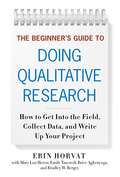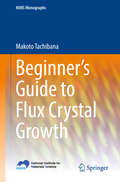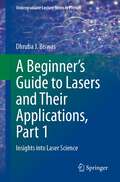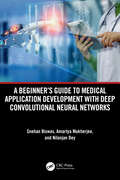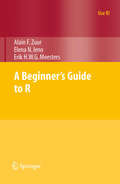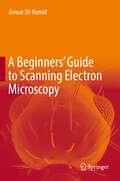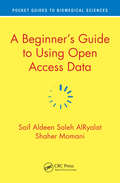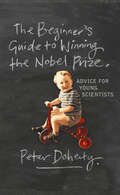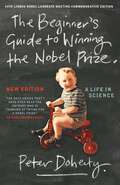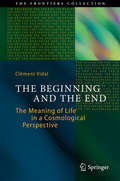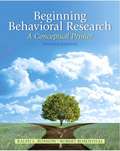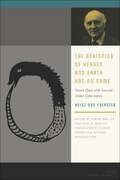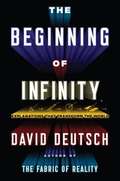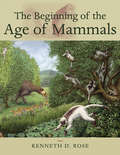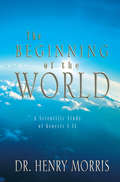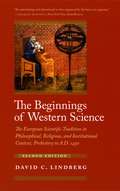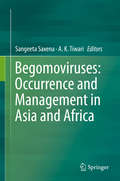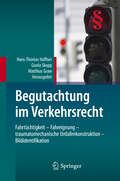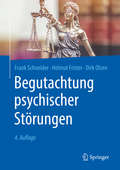- Table View
- List View
The Beginner's Guide to Doing Qualitative Research
by Erin Horvat Mary Lou Heron Emily Tancredi-Brice Agbenyega Bradley W. BergeyDesigned for aspiring ethnographers and qualitative researchers, this book is organized into three parts that addresses the key phases of any ethnographic project: beginning a project, collecting data in the field, and analysing data and writing about your study.
Beginner’s Guide to Flux Crystal Growth (NIMS Monographs)
by Makoto TachibanaThis book introduces the principles and techniques of crystal growth by the flux method, which is arguably the most useful way to obtain millimeter- to centimeter-sized single crystals for physical research. As it is possible to find an appropriate solvent ("flux") for nearly all inorganic materials, the flux method can be applied to the growth of many crystals ranging from transition metal oxides to intermetallic compounds. Both important principles and experimental procedures are described in a clear and accessible manner. Practical advice on various aspects of the experiment, which is not readily available in the literature, will assist the beginning graduate students in setting up the lab and conducting successful crystal growth. The mechanisms of crystal growth at an elementary level are also provided to better understand the techniques and to help in assessing the quality of the crystals. The book also contains many photographs of beautiful crystals with important physical properties of current interest, such as high-temperature superconductors, strongly correlated electronic systems, topological insulators, relaxor ferroelectrics, low-dimensional quantum magnets, non-linear optical materials, and multiferroics.
The Beginner's Guide to Interpreting Ethnic DNA Origins for Family History: How Ashkenazi, Sephardi, Mizrahi & Europeans are Related to Everyone Else
by Anne HartAre you Curious About Your Ethnic Family Origins from Last Century Back 10,000 Years? Genealogists are now using molecular genealogy-comparing and matching people by matrilineal DNA lineages-- mtDNA or patrilineal Y-chromosome ancestry and/or racial percentages tests. Here's how to trace your DNA test results for family history, oral history, ancestry, molecular genealogy, and more. How to find your DNA matches in online DNA databases.
A Beginner’s Guide to Lasers and Their Applications, Part 1: Insights into Laser Science (Undergraduate Lecture Notes in Physics)
by Dhruba J. BiswasThis two-volume book provides an enriching insight into the laser, covering different types of lasers, the basic science behind the technology, their role at the cutting-edge of current scientific research, and their wide-ranging applications. With just high school physics as a prerequisite and favoring qualitative yet scientifically sound explanations over high-level mathematics, this book is aimed at a broad spectrum of readers in physics, chemistry, engineering, medicine, and biology. Its engaging and lucid presentation is enhanced with plenty of illustrations, making the world of the laser accessible to undergraduate students in the sciences and any other inquisitive readers with high school physics under their belts. Furthermore, the text is often laced with anecdotes, picked from history, that are bound to pique the minds of the readers. It is ideal for self-study or as a complement to courses on optics and optoelectronics. This volume, Part 1 of 2, explains the fundamentals of optics, what a laser is, how it works, and what is unique about the light it emits, from fundamental quantum theory through population inversion and cavity to common laser types. It is followed by Part 2 which depicts the many advances in science enabled by the laser, including spectroscopy, nonlinear optics, optical cooling and trapping, and optical tweezers, among many others, and provides a glimpse into the ways that the laser affects our lives via its uses in medicine, manufacturing, the nuclear industry, energy, defence, communication, ranging, pollution monitoring, art conservation, fashion, beauty, and entertainment.
A Beginner's Guide to Medical Application Development with Deep Convolutional Neural Networks
by Snehan Biswas Amartya Mukherjee Nilanjan DeyThis book serves as a source of introductory material and reference for medical application development and related technologies by providing the detailed implementation of cutting-edge deep learning methodologies. It targets cloud-based advanced medical application developments using open-source Python-based deep learning libraries. It includes code snippets and sophisticated convolutional neural networks to tackle real-world problems in medical image analysis and beyond.Features: Provides programming guidance for creation of sophisticated and reliable neural networks for image processing. Incorporates the comparative study on GAN, stable diffusion, and its application on medical image data augmentation. Focuses on solving real-world medical imaging problems. Discusses advanced concepts of deep learning along with the latest technology such as GPT, stable diffusion, and ViT. Develops applicable knowledge of deep learning using Python programming, followed by code snippets and OOP concepts. This book is aimed at graduate students and researchers in medical data analytics, medical image analysis, signal processing, and deep learning.
A Beginner's Guide to R: A Frequentist And Bayesian Perspective For Ecologists (Use R!)
by Elena N. Ieno Alain Zuur Erik MeestersBased on their extensive experience with teaching R and statistics to applied scientists, the authors provide a beginner's guide to R. To avoid the difficulty of teaching R and statistics at the same time, statistical methods are kept to a minimum. The text covers how to download and install R, import and manage data, elementary plotting, an introduction to functions, advanced plotting, and common beginner mistakes. This book contains everything you need to know to get started with R. "Its biggest advantage is that it aims only to teach R...It organizes R commands very efficiently, with much teaching guidance included. I would describe this book as being handy--it's the kind of book that you want to keep in your jacket pocket or backpack all the time, ready for use, like a Swiss Army knife." (Loveday Conquest, University of Washington) "Whilst several books focus on learning statistics in R..., the authors of this book fill a gap in the market by focusing on learning R whilst almost completely avoiding any statistical jargon...The fact that the authors have very extensive experience of teaching R to absolute beginners shines throughout." (Mark Mainwaring, Lancaster University) "Exactly what is needed...This is great, nice work. I love the ecological/biological examples; they will be an enormous help." (Andrew J. Tyne, University of Nebraska-Lincoln)
A Beginners' Guide to Scanning Electron Microscopy
by Anwar Ul-HamidThis book was developed with the goal of providing an easily understood text for those users of the scanning electron microscope (SEM) who have little or no background in the area. The SEM is routinely used to study the surface structure and chemistry of a wide range of biological and synthetic materials at the micrometer to nanometer scale. Ease-of-use, typically facile sample preparation, and straightforward image interpretation, combined with high resolution, high depth of field, and the ability to undertake microchemical and crystallographic analysis, has made scanning electron microscopy one of the most powerful and versatile techniques for characterization today. Indeed, the SEM is a vital tool for the characterization of nanostructured materials and the development of nanotechnology. However, its wide use by professionals with diverse technical backgrounds—including life science, materials science, engineering, forensics, mineralogy, etc., and in various sectors of government, industry, and academia—emphasizes the need for an introductory text providing the basics of effective SEM imaging.A Beginners’ Guide to Scanning Electron Microscopy explains instrumentation, operation, image interpretation and sample preparation in a wide ranging yet succinct and practical text, treating the essential theory of specimen-beam interaction and image formation in a manner that can be effortlessly comprehended by the novice SEM user. This book provides a concise and accessible introduction to the essentials of SEMincludes a large number of illustrations specifically chosen to aid readers' understanding of key conceptshighlights recent advances in instrumentation, imaging and sample preparation techniquesoffers examples drawn from a variety of applications that appeal to professionals from diverse backgrounds.
A Beginner’s Guide to Using Open Access Data (Pocket Guides to Biomedical Sciences)
by Saif Aldeen AlRyalat Shaher MomaniOpen Access Data is emerging as a source for cutting edge scholarship. This concise book provides guidance from generating a research idea to publishing results. Both young researchers and well-established scholars can use this book to upgrade their skills with respect to emerging data sources, analysis, and even post-publishing promotion. At the end of each chapter, a tutorial simulates a real example, allowing readers to apply what they learned about accessing open data, and analyzing this data to reach the results. This book can be of use by established researchers analyzing data, publishing, and actively promoting ongoing and research. Key selling features: Describes the steps, from A-Z, for doing open data research Includes interactive tutorials following each chapter Provides guidelines for readers so that they can use their own accessed open data Reviews recent software and websites promoting and enabling open data research Supplements websites which update recent open data sources
The Beginner's Guide to Winning the Nobel Prize: Advice for Young Scientists
by Peter DohertyIn The Beginner's Guide to Winning the Nobel Prize, Doherty recounts his unlikely path to becoming a Nobel Laureate. Beginning with his humble origins in Australia, he tells how he developed an interest in immunology and describes his award-winning, influential work with Rolf Zinkernagel on T-cells and the nature of immune defense. In prose that is at turns amusing and astute, Doherty reveals how his nonconformist upbringing, sense of being an outsider, and search for different perspectives have shaped his life and work.Doherty offers a rare, insider's look at the realities of being a research scientist. He lucidly explains his own scientific work and how research projects are selected, funded, and organized; the major problems science is trying to solve; and the rewards and pitfalls of a career in scientific research. For Doherty, science still plays an important role in improving the world, and he argues that scientists need to do a better job of making their work more accessible to the public. Throughout the book, Doherty explores the stories of past Nobel winners and considers some of the crucial scientific debates of our time, including the safety of genetically modified foods and the tensions between science and religion. He concludes with some "tips" on how to win a Nobel Prize, including advice on being persistent, generous, and culturally aware, and he stresses the value of evidence. The Beginner's Guide to Winning the Noble Prize is essential reading for anyone interested in a career in science.
The Beginner's Guide to Winning the Nobel Prize: Advice for Young Scientists
by Peter DohertyThe Nobel Prize-winning medical researcher recounts his unlikely career journey in a memoir that &“opens the vault to the world of science&” (Nature). Beginning with his humble origins in Australia, Peter Doherty tells how he developed an interest in immunology and describes his award-winning, influential work with Rolf Zinkernagel on T-cells and the nature of immune defense. In prose that is both amusing and astute, Doherty reveals how his nonconformist upbringing and search for different perspectives have shaped his life and work. Doherty offers an insider's look at the life of a research scientist. He lucidly explains his own scientific work and how research projects are selected, funded, and organized; the major problems science is trying to solve; and the rewards and pitfalls of a career in scientific research. He also explores the stories of past Nobel winners and considers some of the crucial scientific debates of our time, including the safety of genetically modified foods and the tensions between science and religion. He concludes with some "tips" on how to win a Nobel Prize, including advice on being persistent, generous, and culturally aware.
Beginner's Guide to Winning the Nobel Prize: A Life in Science: New Edition
by Peter DohertyIs it possible to be passionate about politics, football or R&B and still be a creative scientist? In this entertaining and inspiring account, Nobel Prize winner Peter Doherty offers readers an insider's guide into discovery science and the individuals who work in it.Starting with the story of his own career and its improbable origins in the outer suburbs of Brisbane, and its progression to a breakthrough discovery about how human immunity works. Doherty explores the realities of a life in science. How research projects are selected; how discovery science is resourced and organised; the big problems it is trying to solve; and the rewards and pitfalls of a career in scientific research: all these are explored in The Beginner's Guide to Winning the Nobel Prize.Doherty gives readers an insight into the issues that make him tick including his belief that the mission of science is to help make the world a better place to live in. He also essays answers to some of the great questions of our age. Are Nobel Prize winners exceptional human beings or just lucky? Are GMO crops really dangerous? And why can't scientists and born-again Christians get along?
The Beginning and the End
by Clément VidalIn this fascinating journey to the edge of science, Vidal takes on big philosophical questions: Does our universe have a beginning and an end or is it cyclic? Are we alone in the universe? What is the role of intelligent life, if any, in cosmic evolution? Grounded in science and committed to philosophical rigor, this book presents an evolutionary worldview where the rise of intelligent life is not an accident, but may well be the key to unlocking the universe's deepest mysteries. Vidal shows how the fine-tuning controversy can be advanced with computer simulations. He also explores whether natural or artificial selection could hold on a cosmic scale. In perhaps his boldest hypothesis, he argues that signs of advanced extraterrestrial civilizations are already present in our astrophysical data. His conclusions invite us to see the meaning of life, evolution and intelligence from a novel cosmological framework that should stir debate for years to come.
Beginning Behavioral Research: A Conceptual Primer
by Ralph Rosnow Robert RosenthalThis successful introduction to behavioral research methods-written by two leaders in the field-provides step-by-step guidance through the processes of planning an empirical study, analyzing and interpreting data, and reporting findings and conclusions. It encourages readers to be analytical and critical, not only in interpreting research findings, but also in investigating what is behind the claims and conclusions in news reports of scientific results. While the primary emphasis is on behavioral and social research, a strong effort is made to connect these disciplines with the empirical reasoning used in other fields in order to underscore the unity of science. The volume examines behavioral research and scientific method, creative ideas and working hypotheses, ethical considerations and guidelines, observation and measurement, design and implementation, describing data and making inferences, and statistical tests. For those interested in an introduction to research methods.
The Beginning of All Things: Science and Religion
by Hans KüngTranslated by John Bowden In an age when faith and science seem constantly to clash, can theologians and scientists come to a meeting of minds? Yes, maintains the intrepid Hans Küng, as he brilliantly argues here that religion and science are not mutually exclusive but complementary. Focusing on beginnings -- beginnings of time, of the world, of man, of human will -- Küng deals with an array of scientific precepts and teachings. From a unified field theory to quantum physics to the Big Bang to the theory of relativity -- even superstring and chaos theories -- he examines all of the theories regarding the beginning of the universe and life (of all kinds) in that universe. Küng seeks to reconcile theology with the latest scientific insights, holding that "a confrontational model for the relationship between science and theology is out of date, whether put forward by fundamentalist believers and theologians or by rationalistic scientists and philosophers." While accepting evolution as scientists generally describe it, he still maintains a role for God in founding the laws of nature by which life evolved and in facilitating the adventure of creation. Exhibiting little patience for scientists who do not see beyond the limits of their discipline or for believers who try to tell experts how things must have been, Küng challenges readers to think more deeply about the beginnings in order to facilitate a new beginning in dialogue and understanding.
The Beginning of Heaven and Earth Has No Name: Seven Days with Second-Order Cybernetics (Meaning Systems)
by Heinz von FoersterHeinz von Foerster was the inventor of second-order cybernetics, which recognizes the investigator as part of the system he is investigating. The Beginning of Heaven and Earth Has No Name provides an accessible, nonmathematical, and comprehensive overview of von Foerster’s cybernetic ideas and of the philosophy latent within them. It distills concepts scattered across the lifework of this scientific polymath and influential interdisciplinarian. At the same time, as a book-length interview, it does justice to von Foerster’s élan as a speaker and improviser, his skill as a raconteur.Developed from a week-long conversation between the editors and von Foerster near the end of his life, this work playfully engages von Foerster in developing the difference his notion of second-order cybernetics makes for topics ranging from emergence, life, order, and thermodynamics to observation, recursion, cognition, perception, memory, and communication.The book gives an English-speaking audience a new ease of access to the rich thought and generous spirit of this remarkable and protean thinker.
The Beginning of Infinity
by David DeutschOld ways of thought permitted no process such as science for correcting errors and misconceptions. So ideas were static for long periods. Being bad explanations, even the best of them typically had little reach and were therefore brittle and unreliable beyond, and often within, their traditional applications. When ideas did change, it was seldom for the better, and when it did happen to be for the better, that seldom increased their reach. The emergence of science, and more broadly what I am calling the Enlightenment, was the beginning of the end of such static, parochial systems of ideas. It initiated the present era in human history, unique for its sustained, rapid creation of knowledge with ever-increasing reach. Many have wondered how long this can continue. Is it inherently bounded? Or is this the beginning of infinity - that is to say, do these methods have unlimited potential to create further knowledge?'Science has never had an advocate quite like David Deutsch. He is a computational physicist on a par with his touchstones Alan Turing and Richard Feynman, and also a philosopher in the line of his greatest hero, Karl Popper. His arguments are so clear that to read him is to experience the thrill of the highest level of discourse available on this planet and to understand it . . . This is the great Life, the Universe and Everything book for our time and the answer is not 42: it is infinity. To understand precisely what Deutsch means by this, you will have to read him. Do so and lose your parochial blinkers forever. ' Independent
The Beginning of the Age of Mammals
by Kenneth D. RoseIn the tradition of G. G. Simpson's classic work, Kenneth D. Rose's The Beginning of the Age of Mammals analyzes the events that occurred directly before and after the mysterious K-T boundary which so quickly thrust mammals from obscurity to planetary dominance. Rose surveys the evolution of mammals, beginning with their origin from cynodont therapsids in the Mesozoic, contemporary with dinosaurs, through the early Cenozoic, with emphasis on the Paleocene and Eocene adaptive radiations of therian mammals. Focusing on the fossil record, he presents the anatomical evidence used to interpret behavior and phylogenetic relationships. The life's work of one of the most knowledgeable researchers in the field, this richly illustrated, magisterial book combines sound scientific principles and meticulous research and belongs on the shelf of every paleontologist and mammalogist.
The Beginning of the World
by Dr Henry M. MorrisA handy study of Genesis 1-11, this book gives insightful commentary into the stories most often labeled as "myth" by those who want to chip away at the Bible. Morris details amazing evidence that the first 11 chapters of Genesis are literal history that shapes us today.
Beginning Teaching with Digital Technology
by Joanne BlanninTeachers are now expected to use technology to enhance students’ learning, but what does this mean in the classroom and how can you apply it effectively to subject teaching? This book, for pre-service and qualified teachers, offers you a guide for using technology in primary and secondary schools, including how to decide which technology resource to use, safeguarding and ethical considerations and computer coding in the classroom. Further guidance is provided on using technology across the learning areas of literacy, mathematics, STEM and the arts. Key features include: · Classroom scenarios which tackle common challenges faced by teachers and how to resolve them · Examples of best practice technology use in early childhood settings, primary and secondary classrooms · A future-proofed approach focusing on theory-informed best practice in an ever-changing world of devices and software Essential reading for pre-service teacher education students in both primary and secondary education courses on undergraduate and postgraduate routes into teaching and for qualified teachers looking to deepen their professional knowledge. Joanne Blannin is Senior Lecturer in Digital Transformations at Monash University.
Beginning Teaching with Digital Technology
by Joanne BlanninTeachers are now expected to use technology to enhance students’ learning, but what does this mean in the classroom and how can you apply it effectively to subject teaching? This book, for pre-service and qualified teachers, offers you a guide for using technology in primary and secondary schools, including how to decide which technology resource to use, safeguarding and ethical considerations and computer coding in the classroom. Further guidance is provided on using technology across the learning areas of literacy, mathematics, STEM and the arts. Key features include: · Classroom scenarios which tackle common challenges faced by teachers and how to resolve them · Examples of best practice technology use in early childhood settings, primary and secondary classrooms · A future-proofed approach focusing on theory-informed best practice in an ever-changing world of devices and software Essential reading for pre-service teacher education students in both primary and secondary education courses on undergraduate and postgraduate routes into teaching and for qualified teachers looking to deepen their professional knowledge. Joanne Blannin is Senior Lecturer in Digital Transformations at Monash University.
Beginnings: The Story of Origins - of Mankind, Life, the Earth, the Universe
by Isaac AsimovClarifying key scientific discoveries, Asimov takes us back through the millenia to the birth of the universe 15 billion years ago, then the first evidence of man and civilization.
The Beginnings of Western Science: The European Scientific Tradition in Philosophical, Religious, and Institutional Context, Prehistory to A.D. 1450 (2nd edition)
by David C. LindbergWhen it was first published in 1992, The Beginnings of Western Science was lauded as the first successful attempt ever to present a unified account of both ancient and medieval science in a single volume. Chronicling the development of scientific ideas, practices, and institutions from pre-Socratic Greek philosophy to late-Medieval scholasticism, David C. Lindberg surveyed all the most important themes in the history of science, including developments in cosmology, astronomy, mechanics, optics, alchemy, natural history, and medicine. In addition, he offered an illuminating account of the transmission of Greek science to medieval Islam and subsequently to medieval Europe. Beginnings of Western Science was, and remains, a landmark in the history of science, shaping the way students and scholars understand these critically formative periods of scientific development. It reemerges here in a second edition that includes revisions on nearly every page, as well as several sections that have been completely rewritten. For example, the section on Islamic science has been thoroughly retooled to reveal the magnitude and sophistication of medieval Muslim scientific achievement. And the book now reflects a sharper awareness of the importance of Mesopotamian science for the development of Greek astronomy. In all, the second edition of The Beginnings of Western Science captures the current state of our understanding of more than two millennia of science and promises to continue to inspire both students and general readers.
Begomoviruses: Occurrence and Management in Asia and Africa
by Sangeeta Saxena A. K. TiwariBegomoviruses are one of the most interesting plant viruses to study for basic and applied research as they cause huge economic losses to agriculture industries and farmers all over the world. They belong to family Geminiviridae and are emergent plant viral pathogens which cause diseases in various crops in the tropical and subtropical regions. They are transmitted by the whitefly (B. tabaci) and have either one (monopartite DNA-A) or two (bipartite DNA-A and DNA-B) genomic components. DNA-A and DNA-B are of ~2600 - 2800 nucleotides each. A number of serious diseases of cultivated crops of the Fabaceae, Malvaceae, Solanaceae and Cucurbitaceae families are caused by Begomoviruses which are considered as threat to their cultivation in many countries. Accurate diagnosis is important for successful diseases management, since plants infected by Begomovirus do not recover, suffer serious yield losses and act as further sources of inoculum, which is then picked up and spread by their vector whitefly (B. tabaci). Reports of occurrence of new viruses and re-emergence of several known viruses in new niches have become regular event. In such a dynamic system, growth of several crop species relies on an accurate diagnosis, management and better understanding of the biology of the casual virus. This is crucial to evolve appropriate control practices and to prevent the virus infection. Researchers have achieved considerable progress in characterization, detection and management of virus on different crop species in the last decade. This book covers latest information in diagnosis of begomoviruses in the present scenario and explores the new vistas in the field of genomics and proteomics. Chapters in Section 1 illustrates the occurrence, genome organisation, transmission and diagnostics of begomoviruses. It also details the diseases caused by begomoviruses on different crops, detection techniques and management strategies in support of research findings by presentation of data, graphics, figures and tables. Section 2 is a chapterwise collection of occurrence, diversity and status of begomoviruses in Asian Africa counties where the diseases are most prevalent. This book will provide wide opportunity to the readers to have complete information and status of begomovirus in Asia and Africa. This will be useful resource for researchers and extension workers involved in the begomvirus disease diagnosis and molecular biology. Expert detection, accurate diagnosis and timely management play a significant role in keeping plants free from pathogens. In this book expert researchers share their research knowledge and literature which are vital towards the diagnosis of begomoviruses, addressing traditional plant pathology techniques as well as advance d molecular diagnostic approach. The book deals with the economically important crops including fruits, vegetables along with challenges in crop protection against diseases caused by begomovirus. This will be resourceful and handy for researcher, practitioners and also students.
Begutachtung im Verkehrsrecht: Fahrtüchtigkeit - Fahreignung - traumatomechanische Unfallrekonstruktion - Bildidentifikation
by Matthias Graw Gisela Skopp Hans-Thomas HaffnerDie Aufgabe des Gutachters im Gerichtsverfahren ist es, Juristen die Fachkenntnisse zu vermitteln, die für die Beurteilung eines Sachverhalts notwendig sind. Um diesen Vermittlungsprozess im Bereich der Verkehrsmedizin zu unterstützen, haben die Autoren das wissenschaftliche Basiswissen verständlich aufbereitet - von der forensischen Toxikologie über die biomechanische Unfallrekonstruktion bis zur anthropologischen Bildidentifikation. Sie zeigen die Möglichkeiten und Grenzen der Begutachtung auf und illustrieren dies anhand konkreter Fallbeispiele.
Begutachtung psychischer Störungen
by Frank Schneider Helmut Frister Dirk OlzenBegutachtungen von Menschen mit psychischen Störungen sind anspruchsvoll und gelten als schwierig. Das vorliegende Standardwerk bietet deshalb einen kompakten und gleichzeitig praxisnahen Leitfaden für ärztliche und psychologische Sachverständige, aber auch eine unverzichtbare und umfassende Grundlage für Juristen. Denn richtige und faire Entscheidungen der Gerichte können nur gefällt werden, wenn sich Mediziner, Psychologen und Juristen untereinander verständigen können. Dieses Buch leistet einen wesentlichen Beitrag zu diesem nicht immer einfachen, aber notwendigen und nicht zuletzt besonders interessanten und spannenden interdisziplinären Austausch. Das Werk zeichnet sich aus durch eine praxisbezogene, verständliche und klare Darstellung der wesentlichen Aspekte der psychiatrischen und psychologischen Begutachtung, ausführliche Beispielgutachten sowie zahlreiche Fallbeispiele aus der Praxis viele Tipps zum Erstellen eines Gutachtens die Darstellung des aktuellen Stands der medizinischen, psychologischen und juristischen Literatur, inklusive der neuesten Rechtsprechung und Gesetzgebung. Mit der nun vorliegenden vierten Auflage wurde das Werk zudem grundlegend aktualisiert. Das Buch ist ein wertvoller Begleiter für Mediziner, Psychologen, Juristen und alle anderen Interessierten, die mit psychiatrischen und psychologischen Gutachten zu tun haben.
